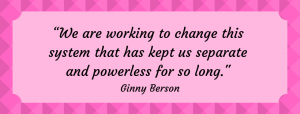
Ginny Berson. “The Furies,” The Furies, vol. 1, no. 1, 1.
Lesbian-feminist ideology is a crucial component to understanding the foundation and goals of the Furies as a political and separatist organization. In the first article of their first periodical, Ginny Berson writes, “We are working to change the system that has kept us separate and powerless for so long.”1 The main way that the Furies chose to separate themselves from other groups was based on gender identity and sexual orientation. To the Furies, it was crucial that women separate themselves from patriarchal institutions by refusing to engage in heterosexuality.
The Furies reinforce the idea of political lesbianism throughout the span of their periodicals. “Lesbianism is not a matter of sexual preference, but rather one of political choice which every woman must make to become woman-identified and thereby end male supremacy,” Berson also declared in her manifesto-like article.2 To Berson and the other Furies, heterosexuality was a prison in which women were trapped. They also believed that a woman could not work for the betterment of other women until she rejected all physical attachments to men, including romantic relationships or even casual ones; moreover, “any woman relating to a man cannot be a feminist.”3 The idea that sexuality is an intellectual choice rather than an inherent identity and preference, as well as the idea that women who love men cannot be feminists, greatly contrasts the ideas that many feminists and members of the LGBTQ+ community possess today. However, it should be noted that these stances directly evolved from the exclusionary and homophobic nature of both the Male Left and Women’s Liberation Movements. For the Furies, just as being a woman was political, being a lesbian was also a political act.
As mentioned above, the Furies’ main justification for their political lesbianism and separatist movement stems from the homophobic politics of both the Male Left and Women’s Liberation movement. Most obviously, the Furies took issue with the Male Left because they were typically reticent to actually attack the root of sexism: male dominance. Many of the Furies got their start as political activists in the Women’s Liberation Movement; in fact, Rita Mae Brown was an organizer of their efforts for years.4 However, it was these women’s participation in the WLM that exposed them to the problematic nature of that movement in itself: “The Women’s Movement was failing too many women. It was oppressive to lesbians, working class women, non-white women (the most obvious and least understood), young women, older women, artists, leaders or individuals with initiative, followers who were manipulated, mothers, etc.”5
The WLM, unfortunately, prioritized the liberation of heterosexual, middle-class, white women above the rights of any other groups. Upon publicly coming out to her women’s group at university, Jennifer Woodul reflects on how she was no longer taken seriously by straight women in the movement, a problem that was spread across much of the WLM.6 Besides the prioritization of women that fit one specific category, the Furies also claim that the undefined ideology of both women’s and lesbian movements inspired them to form their own separatist group. “A political movement cannot advance without systematic thought and practical organization. The haphazard, non-strategic, zig-zag tactics of the straight women’s movement, the male left, and many so-called revolutionary groups have only led to frustration and dissolution,” Berson writes.7 It is clear here that the Furies desired a more clear and goal-oriented movement.
The Furies stress that a well-defined collective ideology is one of the key components for a meaningful movement that actually enacts change rather than simply raising awareness. “We have to start making ideology the priority of our small groups,” Coletta Reid states, “We need to know what institutions are most important to keeping men in power and where they are vulnerable. We have to understand how the power of men is built on the oppression of women.”8 For the Furies, haphazard attempts at changing a system that has oppressed women for so long would not suffice. Instead, groups and collectives needed to understand the force that they oppose and develop tactics for opposing that force. Although the Furies never published a step-by-step guide to their group ideologies, they do cite The Furies as one of the main factors that forced them to define what exactly their beliefs were.9 The ideological principles of their political identities are in part why the Furies valued their identities as lesbians and feminists as much as they did. By understanding the principled nature of their sexual identities, one may better understand the highly radical and political of this group.
1Ginny Berson, “The Furies,” The Furies, vol. 1, no. 1, January 1972, pp. 1.
2Ibid.
3Barbry, “Taking the Bullshit by the Horns,” The Furies, vol. 1, no. 3, March/April 1972, 9.
4Rita Mae Brown, “Out of the Sea of Discontent,” The Furies, vol. 1, no. 5, June/July 1972, 16.
5Charlotte Bunch, “Perseverance Furthers: Separatism and Our Future,” The Furies, vol. 1, no. 7, Fall 1972, 3.
6Jennifer Woodul, “Darers Go First,” The Furies, vol. 1 no. 5, June/July 1972, 2.
7Ginny Berson, “The Furies,” The Furies, vol. 1, no. 1, January 1972, 1.
8Coletta Reid, “Ideology: Guide to Action,” The Furies, vol. 1, no. 3, March/April 1972, 6.
9Coletta Reid, “Details…,” The Furies, vol. 1, no. 5, June/July 1972, 7.